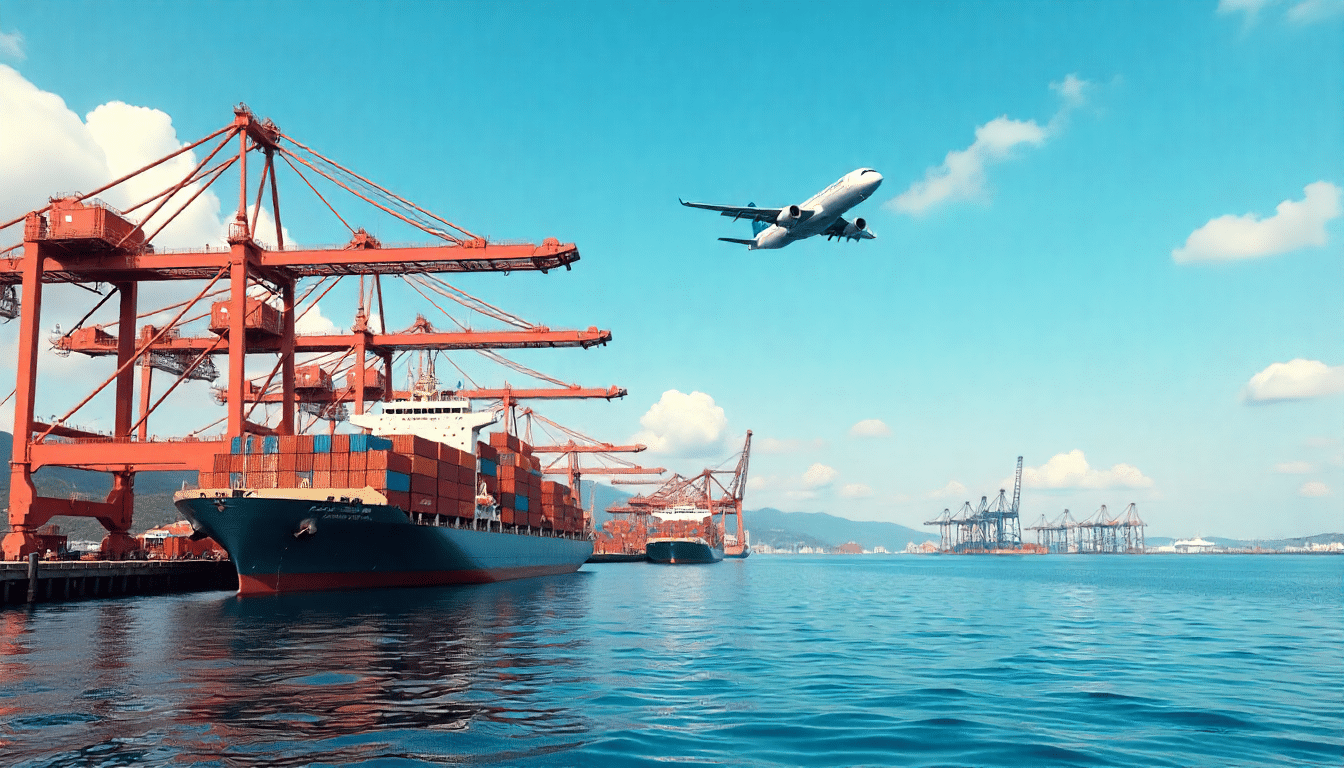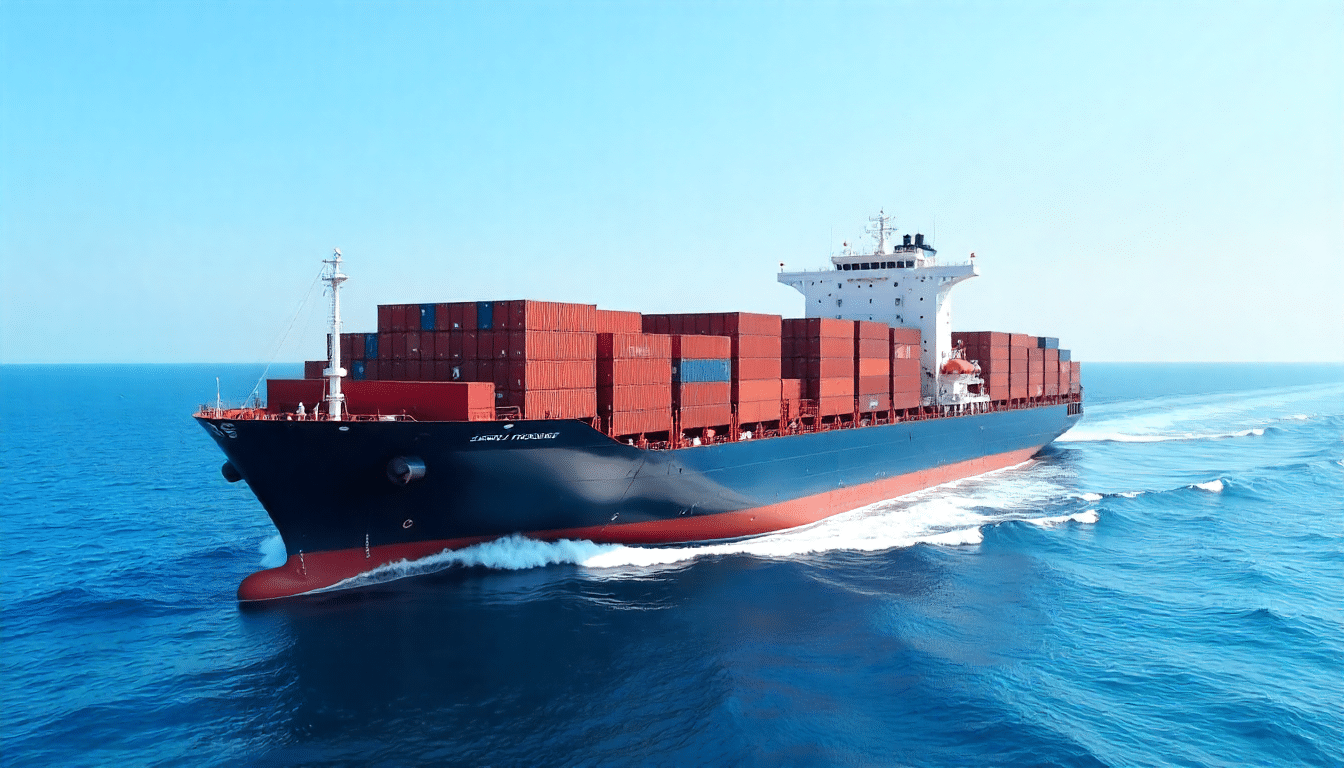Global Logistics in Japan: How Chinese Freight Forwarders Balance Time, Cost, and Compliance
By Guanwutong / October 28, 2025
The world of global logistics is complex, but the Japanese market represents a unique level of challenge. For businesses sourcing from China, Japan is a land of immense opportunity, driven by a mature consumer base and the world’s third-largest e-commerce market. However, it is also a market defined by exacting standards, zero tolerance for delays, and complex regulatory hurdles.
This is where the specialized role of a Chinese freight forwarder becomes a strategic advantage. While global giants offer scale, and local Japanese forwarders offer deep domestic knowledge, a Chinese freight forwarder dedicated to the logistics network between China and Japan acts as the essential bridge. They combine mainland consolidation power with the nuanced, localized service required for successful China-to-Japan shipping.
This guide analyzes the problems (the pain points) of the critical China-Japan shipping route and presents the solutions (the methods) that effective forwarders use to manage time, cost, and compliance. We will cover the core demands of the Japanese market, the practical service solutions you should look for, and the future of this critical supply chain.

1. Core Demands & Pain Points in the Japanese Market
Successfully navigating global logistics in Japan means understanding the market’s fundamental expectations. These demands are often the biggest pain points for international shippers.
The “Zero-Error” Expectation for Timing (JIT Culture)
Japan’s business culture is built on the “Just-in-Time” (JIT) manufacturing and retail model. This isn’t just a preference; it’s an operational requirement. In fact, according to analysis based on METI (Ministry of Economy, Trade and Industry) data, over 60% of Japan’s manufacturing partners operate on JIT delivery schedules with less than 24-hour tolerance windows.
The Pain Point: Shippers face high penalties (contractual or reputational) for delays. Volatile shipping schedules make promises hard to keep, and a container arriving two days late isn’t an inconvenience; it can halt a production line or trigger penalties from e-commerce platforms like Rakuten and Amazon Japan.
Complex Customs and Strict Compliance
Japan Customs is highly efficient but notoriously strict.
The entire process relies on absolute accuracy. Common goods, like cosmetics, food products, or electronics with batteries, fall under the jurisdiction of various ministries (e.g., Ministry of Health, Labour and Welfare – MHLW).
A simple error in an HS code, a missing ingredient list for a food supplement, or an incorrect valuation can lead to cargo being held for weeks.
The Pain Point: Businesses face costly delays, storage fees (demurrage), and even the risk of their goods being destroyed or re-exported, all because of a documentation error made thousands of miles away.
The “High-Touch” Localization Requirement
Service quality in Japan is non-negotiable and extends beyond simple delivery. Japanese B2B partners and B2C consumers expect seamless, polite, and bilingual (Japanese/English) customer service. Furthermore, the market has a high, and legally protected, rate of product returns (reverse logistics).
The Pain Point: A shipper in China cannot simply “drop” a container at the port. They need a partner who can manage last-mile delivery, handle customer inquiries in Japanese, and efficiently process returns. This is often the most overlooked part of international shipping from China.
For any questions, feel free to contact GWT Shipping. Our team will provide professional, standards-compliant advice tailored to your specific needs.
2. The Unique Advantage of Chinese Freight Forwarders in Japan
Why choose a Chinese freight forwarder for this demanding market? Their competitive edge lies in a hybrid model that balances mainland efficiency with Japanese precision.
Unmatched Network and Consolidation in China
A Chinese freight forwarder has deep roots at the source. They operate extensive networks within China’s manufacturing hubs (e.g., Shenzhen, Yiwu, Shanghai, Qingdao).
This allows them to offer:
Cost-Effective Consolidation: They can combine smaller LCL (Less than Container Load) shipments from multiple factories into a single FCL (Full Container Load), drastically reducing the China-to-Japan logistics cost per unit.
Multi-Modal Flexibility: They have the relationships to seamlessly pivot between standard sea freight, fast sea freight (e.g., to Hakata or Osaka), air freight, and integrated sea-air models to balance cost and speed.
Transparent Cost Structures and Flexibility
Compared to larger global carriers, many Chinese freight forwarders offer more flexible and transparent pricing. They are often better equipped to create customized global freight services for small to medium-sized enterprises (SMEs) and e-commerce sellers, avoiding the rigid, one-size-fits-all contracts of their larger competitors.
The “Bridge” Model: Synergy with Japanese Partners
This is the most critical advantage. The best Chinese freight forwarders do not try to do everything themselves in Japan. Instead, they build strong, synergistic relationships with:
Licensed Japanese Customs Brokers : These local experts handle the complex, in-the-weeds Japan import customs clearance, utilizing the NACCS (Nippon Automated Cargo and Port Consolidated System) for pre-clearance.
Local Last-Mile Carriers: They have contracts with Japanese domestic delivery giants (like Yamato, Sagawa Express, or Japan Post) to ensure the high-service-level delivery that customers expect.
Overseas Warehouses: They manage 3PL warehousing in Japan for inventory buffering, order fulfillment, and managing returns.
This hybrid model gives the client a single point of contact (the Chinese freight forwarder) who manages the entire end-to-end shipping solution, from the factory floor in China to the customer’s door in Tokyo.

3. Service Portfolios: Practical Solutions for the Japanese Market
A forward-thinking Chinese freight forwarder offers a suite of global logistics solutions tailored specifically for the Japanese market’s pain points.
Solution 1: The “Sea + Overseas Warehouse” Strategy (The JIT Buffer Model)
This is the workhorse solution for most consumer goods and e-commerce. Instead of shipping direct-to-customer, goods are shipped via cost-effective sea freight to a 3PL warehouse in Japan (often near major ports like Tokyo, Osaka, or Kobe). This creates a buffer of inventory inside Japan.
When a Japanese customer places an order, it is fulfilled domestically, guaranteeing the fast, precise delivery times (1-2 days) that the JIT culture demands. It also dramatically simplifies the returns process, as returns are sent to a local Japanese address.
Best For: Apparel, home goods, non-perishable B2B supplies, and standard e-commerce.
Solution 2: Air Freight & Express Channels (The Speed Model)
For high-value or time-critical goods, air freight is essential. The forwarder manages direct flights from major Chinese airports (PVG, SZX) to Narita (NRT) or Kansai (KIX), including managing all customs pre-clearance to ensure goods are released within hours of landing, not days.
This is the only way to meet urgent deadlines for product launches or to ship perishable goods. An experienced freight forwarder in China has blocked-space agreements with airlines, ensuring capacity even during peak season.
Best For: High-value electronics, seasonal fashion, medical supplies, and urgent B2B parts.
Solution 3: DDP Shipping to Japan (The All-in-One Model)
DDP (Delivered Duty Paid) means the seller pays all costs to get the goods to the final destination. Your Chinese freight forwarder bundles the entire China-to-Japan logistics cost, including freight, insurance, customs brokerage, import duties, and taxes, into a single, all-inclusive price.
It eliminates all logistical and financial surprises. The seller knows their exact landed cost per unit, making budgeting simple. The Japanese customer receives their package with no surprise COD (Cash on Delivery) bills for taxes, which is a major cause of customer dissatisfaction.
Best For: E-commerce platforms (Shopify, Amazon FBM), B2B samples, and businesses that want to provide a seamless “local” buying experience.
Solution 4: Comprehensive Localization Support (The Service Model)
This service moves a forwarder from a shipper to a true partner. It involves providing Japanese-language customer support for tracking inquiries, managing customs issues, and handling returns.
It solves the language and service-culture barrier. A Japanese B2B buyer feels secure knowing they can speak to someone in their own language who understands the status of their shipment. It builds crucial trustworthiness and allows clients to focus on their core business.

4. Regional Comparison: Why the China-Japan Lane is Unique
To understand the value of a specialized Chinese forwarder, it helps to compare the logistics network between China and Japan with other regional lanes.
vs. China-USA/Europe
These long-haul routes are focused on volume and container optimization. Transit times are measured in weeks, and the final-mile delivery is complex but managed by massive domestic networks. The challenge is less about precision and more about scale.
vs. China-Korea
This lane is operationally similar to Japan (short sea transit, high-frequency shipments), but Japanese customs compliance and service expectations are generally considered more stringent and less tolerant of errors. Korea offers slightly more flexibility in documentation and timing.
The China-Japan Uniqueness
This lane is a high-frequency, high-precision balancing act. A Chinese forwarder is not just managing a shipment; they are managing a daily, high-stakes shuttle service.
Their expertise is in the consolidation at the origin (China) and the deep integration with specialized partners at the destination (Japan).
A local Japanese forwarder may lack the consolidation power in China, and a global giant may lack the flexibility and customized service required for Japanese compliance and the speed of this particular corridor.
5. Practical Checklists: Managing Cost, Time & Risk
This is an actionable framework for working with your forwarder, designed for easy scanning.
Cost Control Checklist
Demand Itemized Quotes: Never accept a single “all-in” price. Demand a quote that breaks down freight, origin/destination charges, customs brokerage, and duties/taxes. This is the only way to compare forwarders fairly and understand the total China-to-Japan logistics cost.
Understand Incoterms (DDP): Clarify your shipping terms. For most e-commerce, a DDP shipping solution provides the most cost certainty and best customer experience, as your forwarder handles all risk and cost to the final door.
Audit Warehouse Fees: If using an overseas warehouse, get a clear fee schedule: Inbound (per pallet/carton), Storage (per day/cubic meter), and Outbound (per order/item).
Time Optimization Checklist
Prepare Documentation: Have your Commercial Invoice, Packing List, and Certificate of Origin (if needed) 100% accurate and ready before the ship sails.
Verify HS Codes: Confirm your 6-digit HS Code with your forwarder and your Japanese customs broker in advance. This is the first cause of customs delays.
Use Pre-Clearance: Ask your forwarder if they use Japan’s NACCS system for pre-clearance. This allows customs to review paperwork while the cargo is still on the water, enabling release almost immediately upon arrival.
Risk & Compliance Checklist
Secure Cargo Insurance: Do not rely on carrier liability (which is minimal). Purchase comprehensive cargo insurance for every shipment. It is inexpensive and protects you from catastrophic loss.
Confirm Product Compliance: If you ship food, cosmetics, toys, or medical-related items, confirm you have all necessary Japanese import licenses (e.g., from the MHLW) before shipping. Your forwarder is not a magician; they cannot fix this at the border.
Check Packaging: Ensure your packaging is robust for international transit and meets any Japanese labeling requirements, especially for e-commerce.
Case Study: Transforming Japan Exports with Process Clarity
The Situation: A Shenzhen manufacturer struggled with unpredictable LCL (Less than Container Load) exports from Shekou to Tokyo, experiencing frequent delays and confusing documentation. The core problem was a lack of process transparency from their previous forwarder.
Our Solution: We secured a stable, competitive LCL carrier and immediately focused on client education. We provided a clear, step-by-step timeline detailing every milestone: from cargo pickup, through consolidation, to the exact customs release timing in Tokyo.
Crucially, we synchronized the manufacturer’s schedule with our compliance team, verifying HS codes and pre-preparing all export documents. Our licensed Japanese partners then submitted NACCS pre-clearance while the shipment was still en route.
The Result:
Within three months, the client achieved a complete transformation:
Reliability was fully restored: Ship dates became entirely predictable, allowing the manufacturer to meet client deadlines confidently.
Operational efficiency soared: Documentation errors ceased, which completely eliminated the stressful risk of customs surprises in Japan.
Critically, the client’s confidence was rebuilt because they finally understood and trusted the transparency of the entire logistics process.
Key Lessons:
Transparency is Professional Service: Demand a forwarder who clearly explains the process.
Prevention Wins: Delays are typically caused by documentation errors; meticulous pre-planning is essential.
The Bridge Model: Successful Japan exports require dual expertise: strong LCL consolidation in China and local compliance management (like NACCS) in Japan.
Conclusion
Successfully landing global logistics in Japan is not about finding the cheapest freight forwarder in China. It is about finding a strategic partner who understands that the Japanese market competes on precision, compliance, and service.
A specialized Chinese freight forwarder acts as this vital bridge, connecting the world’s largest manufacturing hub with one of its most demanding markets. By mastering the hybrid model, combining mainland cost-efficiency with Japanese regulatory precision and service standards, they provide a genuine end-to-end shipping solution. They don’t just move boxes; they manage the complex interplay of time, cost, and compliance that defines success in Japan.
FAQ
The most critical factor is a dual expertise: deep consolidation and export process control in China, combined with a robust network of licensed Japanese partners (customs brokers and last-mile carriers). Simply being cheap is not enough; reliability and compliance are what win in Japan.
For a well-prepared shipment using the NACCS pre-clearance system, cargo can be cleared within hours of arrival. However, if there are documentation errors, or if the goods are flagged for inspection (especially food or medical items), it can take anywhere from 3 days to 3 weeks. An experienced forwarder minimizes this risk through meticulous pre-shipment auditing.
The most common mistake is incorrect or incomplete documentation. This includes mismatched values on the commercial invoice, ambiguous product descriptions, or failing to obtain the correct import licenses (e.g., from the MHLW for cosmetics). This mistake is 100% preventable with an expert partner.
Yes, DDP (Delivered Duty Paid) shipping is an excellent option for e-commerce sellers. Under DDP, the Chinese freight forwarder handles all freight, duties, taxes, and final delivery, quoting the client a single, all-inclusive price. This removes all logistical burdens and risk from the seller and ensures a good customer experience.
This is a critical pain point. An effective forwarder manages returns via their Japanese overseas warehouse. Customers send returns to this local address. The forwarder then inspects the items, consolidates them, and ships them back to China in bulk, which is far more cost-effective than processing individual international returns.
Yes, the base cost of air freight is significantly higher (often 5-10x per kg). However, the “total cost” is more nuanced. Air freight eliminates the need for large inventory buffers, reduces capital tied up in transit, and has lower insurance premiums. For high-value, low-weight goods (like electronics), air freight can often be the more profitable choice.
Look beyond the price. Ask them to show you their digital tracking system. Ask for a case study of how they handled a complex shipment to Japan. And most importantly, ask them to name their Japanese customs brokerage partner. A professional forwarder will have this information readily available.
Global giants (like DHL, Kuehne + Nagel) offer an extensive global network but can be rigid and expensive. A specialized Chinese freight forwarder offers deep expertise and consolidation power at the origin (China) and a more flexible, customized service at the destination (Japan), often acting as a more agile and cost-effective partner for the specific China-Japan shipping route.
Ready to simplify your Japan shipping strategy?


Thank you for reading!
Have questions, corrections, or better ideas? We’d love to hear from you!
We value every piece of feedback and promise to reply within 24 hours. Let's make this guide better together!
Note: Spam comments will not be published.